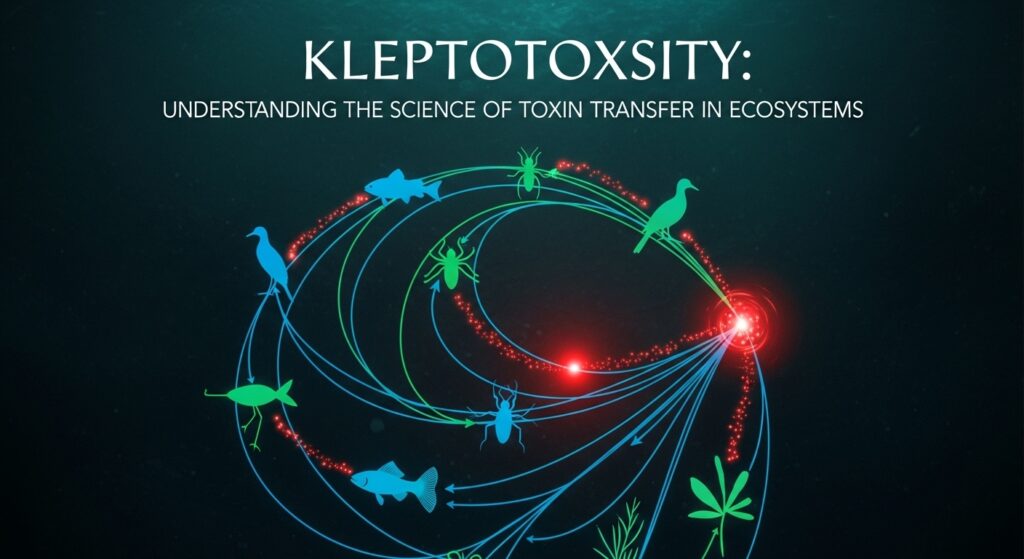In the complex web of ecological interactions, chemical defenses play a crucial role in the survival of many organisms. One fascinating phenomenon that has captured the attention of ecologists and toxicologists is kleptotoxicity. This concept refers to the acquisition and transfer of toxins from one organism to another, often through predation or other ecological interactions. Kleptotoxicity highlights the intricate ways in which toxins can move through ecosystems and influence species behavior, survival strategies, and food web dynamics.
This article explores what kleptotoxicity is, how it occurs, its ecological implications, and its significance in understanding the evolution of chemical defense mechanisms.
What Is Kleptotoxicity?
Kleptotoxicity is the process by which one organism acquires toxins from another organism, usually through consumption, and either stores them or passes them along to a predator. Unlike endogenous toxin production—where organisms synthesize toxins themselves—kleptotoxicity involves sequestering or “stealing” chemical defenses from another species.
The term originates from “klepto-,” meaning to steal, and “toxicity,” referring to poisonous effects. In ecological terms, kleptotoxicity demonstrates how organisms can gain a survival advantage without investing energy into producing toxins themselves.
How Kleptotoxicity Occurs
Kleptotoxicity can occur in several ways:
1. Predation
A predator consumes a toxic prey and sequesters the toxins in its own tissues. This can serve as a defense mechanism against the predator’s own threats.
2. Herbivory
Some herbivorous insects feed on toxic plants, sequestering plant toxins into their bodies. These chemicals make them distasteful or poisonous to their own predators.
3. Parasitism and Symbiosis
In certain ecological interactions, parasites or symbionts may acquire toxins from their hosts to deter their own predators or competitors.
4. Secondary Transfer
Toxins can also move indirectly through the food chain. For example, a predator consumes a kleptotoxic prey, indirectly gaining chemical defenses initially obtained from another organism.
Examples of Kleptotoxicity in Nature
Kleptotoxicity is observed in various ecosystems, often involving insects, amphibians, and marine animals:
1. Insects
Many insects, such as monarch butterflies and certain beetles, feed on toxic plants and store plant alkaloids or cardenolides in their tissues. This makes them unpalatable or harmful to birds and other predators.
2. Amphibians
Some poison dart frogs acquire toxins by consuming arthropods containing alkaloids. Frogs do not synthesize these toxins themselves but sequester them for defense.
3. Marine Animals
Certain marine mollusks and fish consume toxic algae or sponges, storing toxins in their tissues to deter predators.
4. Birds
Bird species may prey on toxic insects and sequester toxins, gaining chemical protection against larger predators.
Ecological Significance of Kleptotoxicity
Kleptotoxi-city has profound implications for ecosystems and evolutionary biology:
1. Predator-Prey Dynamics
By acquiring toxins from their prey, organisms can influence predator-prey interactions, deterring attacks and altering feeding behaviors.
2. Evolution of Chemical Defense
Kleptotoxi-city allows organisms to gain chemical protection without the metabolic cost of producing toxins, influencing evolutionary strategies in various species.
3. Trophic Transfer
The phenomenon demonstrates how toxins move through food webs, affecting multiple trophic levels and ecosystem stability.
4. Species Interactions
Kleptotoxicity can impact competition, parasitism, and mutualism, shaping the interactions and survival strategies of diverse species.
Research and Applications
Studying kleptotoxicity has applications beyond ecology:
1. Conservation Biology
Understanding toxin transfer can aid in managing species that rely on chemical defenses, ensuring the preservation of delicate ecosystems.
2. Pharmacology and Biotechnology
Natural toxins acquired through kleptotoxicity may inspire the development of drugs, antimicrobial agents, or bioinspired chemical compounds.
3. Pest Management
Insights into how insects acquire and utilize plant toxins can inform strategies for controlling pest species without harming beneficial organisms.
Challenges in Studying Kleptotoxicity
Despite its importance, kleptotoxi-city is challenging to study:
-
Complexity of Food Webs: Tracing toxin transfer across multiple species requires sophisticated chemical analyses.
-
Variation in Toxin Storage: Not all organisms sequester toxins equally; the efficiency can vary by species, age, or environmental conditions.
-
Ecological Context: Kleptotoxicity is influenced by ecological variables such as predator presence, food availability, and habitat type.
Conclusion
Kleptotoxicity is a fascinating ecological phenomenon that highlights the complex interplay between organisms and their environments. By acquiring toxins from other species, organisms can enhance survival, influence predator-prey dynamics, and shape evolutionary strategies. Studying kleptotoxicity deepens our understanding of ecological interactions, chemical defense mechanisms, and the intricate flow of toxins through ecosystems.
As research in this field advances, kleptotoxicity offers exciting opportunities for applications in conservation, pharmacology, and biotechnology, demonstrating how nature’s strategies can inspire innovative solutions for humans while preserving ecological balance.






